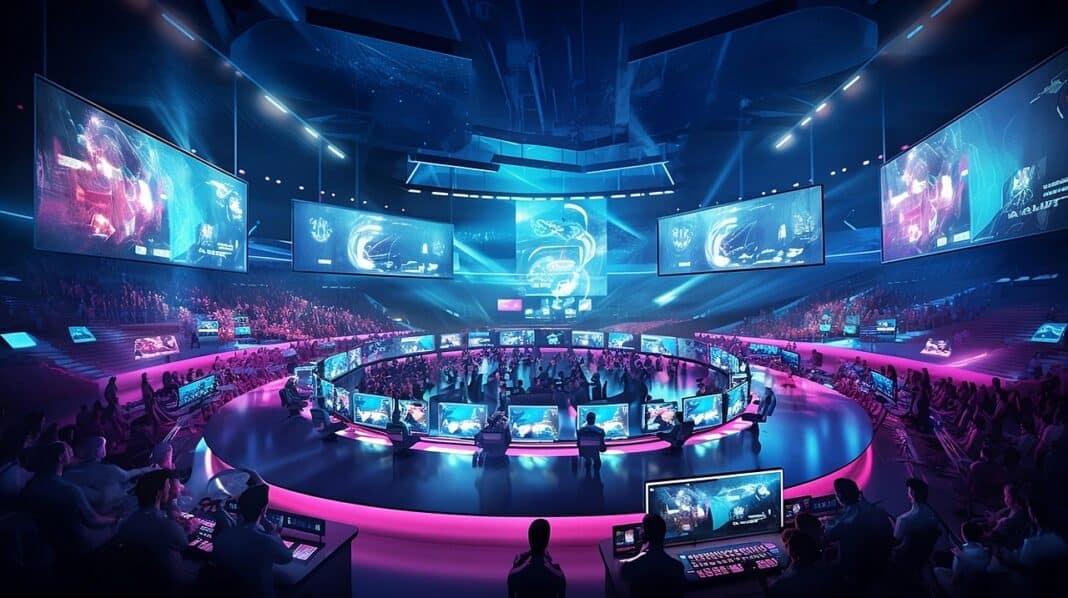How esports evolved from arcade halls to billion-dollar arenas and global competitions
Competitive video gaming — esports — has leveled up from high-score arcades and LAN cafés to sold-out arenas, pro teams, and multi-million-dollar prize pools. This guide traces the history of esports from its scrappy beginnings to today’s modern esports industry, and why many now see the rise of esports as part of entertainment’s mainstream.
Humble Beginnings in the Arcade Era
Esports roots reach back to late-1970s/1980s arcades: high-score chases on Space Invaders, Pac-Man, and more. In 1980, Atari’s Space Invaders Championship drew an estimated 10,000 participants across the U.S., hinting at a competitive spark. Through the ’90s, as consoles/PCs spread, the fighting-game community rallied around Street Fighter and Mortal Kombat, while StarCraft, Quake, and later Counter-Strike built their own circuits — often DIY events in hotel ballrooms or packed internet cafés.
“From bragging rights to brackets and brackets to broadcasters — that’s the arc of early esports.”
The 2000s: Online Play & Global Tournaments

Broadband changed everything. With always-on connections, competition leapt from local meetups to global ladders. South Korea trailblazed with televised StarCraft leagues and celebrity pros. New organizers (e.g., Major League Gaming in 2002) grew multi-game circuits and raised prize totals. Genres canonized for competition included RTS (StarCraft), FPS (Counter-Strike, Halo), fighting (Street Fighter, Smash), and sports titles.
The Modern Boom — Stadiums, Streams, Sponsors
Streaming Platforms
Twitch (2011) and live-streaming made spectating as simple as clicking a link. Global finals for titles like League of Legends drew massive audiences — the 2018 Worlds Finals neared the 100-million unique-viewer mark, with tens of millions watching concurrently. (See sources below.) Streaming platforms accelerated the rise of esports, making tournaments accessible worldwide and driving massive audience growth.
Big Money & Sponsors
Where fans go, brands follow. Tech, beverages, and traditional-sports owners entered team ownership and event sponsorship. Prize pools ballooned — Dota 2’s The International 2021 set an all-time record at about $40 million for a single event. Industry revenue has hovered around/beyond the $1-billion mark in recent years as sponsorships, media rights, and merch matured. (See sources below.)
Arenas & Global Events
Esports graduated from expo halls to marquee venues — think Madison Square Garden or Seoul World Cup Stadium. Multi-nation events joined in: esports became a medal sport at the Asian Games (Hangzhou), and the IOC debuted an Olympic Esports Week in 2023. In 2027, the IOC plans the inaugural Olympic Esports Games. (See sources below.)
Esports as a Profession
Top players often turn pro in their late teens, training 8+ hours daily with coaches, analysts, and sports psychologists. Many live in team facilities; fitness and ergonomics matter for stamina, focus, and injury prevention. Universities have followed suit — hundreds of U.S. colleges now offer esports scholarships or varsity programs, further legitimizing the path. (See sources below.) This comparison shows why the rise of esports is now placed alongside football or basketball in terms of reach and engagement.
Expert tip: Structured schedules, VOD review, and posture/wrist care are as crucial as raw mechanics for longevity.
Major Esports & Their Scenes
- League of Legends (LoL): 5v5 MOBA with a globetrotting league system and a World Championship known for show-stopping ceremonies.
- Dota 2: MOBA famed for The International’s crowdfunded prize pools.
- Counter-Strike (CS): Decades-deep FPS circuit with iconic majors.
- Fortnite: Battle-royale phenom; its 2019 World Cup awarded $3M to a 16-year-old champion.
- Overwatch, Call of Duty, PUBG, VALORANT: Each sustains robust leagues/majors worldwide.
- Sports & FGC: FIFA/EA Sports FC, NBA 2K; and Street Fighter, Tekken, Smash anchor the FGC with EVO as a yearly focal point.
Culture, Challenges & Player Well-Being
Esports developed its own vocabulary, heroes, and rituals — and proved resilient during the pandemic when remote play kept competitions going. Alongside growth came familiar sports issues: burnout and short career arcs, repetitive-strain injuries, inclusion gaps (female pros are still under-represented), and the need for anti-doping policies in a focus-intensive environment.
Counterpoint: Progress is visible — more orgs fund health staff, schedule reforms, and inclusion initiatives; regulation and player unions remain active topics.
Esports vs. Traditional Sports
By common definitions (skillful, competitive, spectator entertainment), esports fits the bill. The overlap grows: sports networks broadcast majors; football and basketball clubs own esports squads; arenas host finals to roaring crowds.
“The drama is real — the ball is virtual.”
What’s Next
Expect the esports as a global phenomenon story to continue: interactive streams, mobile-first regions, more collegiate pathways, and national teams at multi-sport events. Global audience projections approach the mid-hundreds of millions, and new formats (VR, creator-led showmatches) blur lines between sport and show.
Bottom line: The journey truly ran from arcades to arenas — and the next arena may be one tap away on your phone.
Mini-FAQ
Are esports “real” sports?
They check the core boxes: skill, competition, strategy, and spectatorship. Physical demands differ, but coordination, stamina, and teamwork are intense.
How do players make money?
Salaries from orgs, prize winnings, sponsorships, streaming revenue, and creator collaborations.
How can a newcomer watch?
Start with a major final (LoL Worlds, a CS major, TI). Streams are free; broadcasts explain format and strategy as you watch.
Further Reading
- IOC: Olympic Esports Week (overview)
- Reuters: Olympic Esports Games set for 2027
- Esports Insider: 2025 revenue & marketing stats
- Hotspawn: How The International works (incl. 2021 prize pool)
- Polygon: LoL Worlds 2018 viewership (near 100M)
